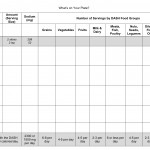Winnsboro Medical Clinic>Nutrition>Healthy Diet & High Blood Pressure
Blood pressure is the force blood against the walls of our arteries and blood vessels, much like that of water in our pipes and hoses. Throughout the day our blood pressure naturally rises and falls. High blood pressure, or hypertension, is when those pressures remain constantly high, forcing the heart to work too hard and putting our blood vessels under lots of stress. Hypertension can lead to many complications and usually has no signs or warnings.
However the good news is that dietary changes, increased exercise, or weight loss can help treat and/or prevent high blood pressure. An effective way to help treat or prevent high blood pressure is to adopt an eating plan. One such plan that has been proven to work is the Dietary Approaches to Stop Hypertension (DASH) diet, which emphasizes:
- Low in saturated fat, cholesterol, and total fat
- Increased in fruits, vegetables, and fat-free/low-fat milk and dairy
- Increased in whole grain products, fish, poultry, nuts
- Reduced in red meat, sweets/candy, sugary drinks (soda), and added sugars
- Rich in heart-healthy minerals, such as Potassium, Calcium, Magnesium, as well as Fiber.
The DASH diet was tested by 2 large studies, supported by the National Heart, Lung, and Blood Institute, comparing the DASH diet to others. The DASH diet was shown to reduce blood pressure the most and the changes came fast – within 2 weeks of starting the diet. Furthermore, the benefits of the DASH diet are additive to a low-sodium diet!
Getting Started
- Change gradually.
- Slowly add more servings of vegetables and fruits to each of your daily meals.
- Change over to low-fat or fat-free milk and dairy products.
- Find alternative drinks instead of sodas or sweet tea, such as water (w/ lemon if preferred or unsweetened tea).
- Use sugar substitutes instead of real sugar and salt substitutes in foods instead of adding salt.
- Read Nutrition Labels and choose alternatives that are lower in saturated and trans fats.
- Treat meats as one part of the meal instead of the focus.
- Limit meats to 6 ounces a day, which is you would normally need. Try to have 3 ounces per meal (about the size of a deck of cards)
- Cut back large portions of meat back gradually.
- Try including 2+ meatless meals into your week.
- Increase the servings of vegetables, brown rice, whole wheat pasta, and cooked dry beans in each meal.
- For desserts & snacks, eat fruit or other foods low in saturated fat, trans fat, cholesterol, sodium, sugar, and calories.
- Carry fresh fruits with you to work as a snack. Washed fruit are easy and need little preparation.
- For canned fruits, choose those that are canned in their own juice or packed in water.
- Dried fruits are a great option and last a long time. Compare Nutrition Labels and choose those with little or no added sugar if possible.
- Other snack ideas:
- unsalted rice cakes
- nuts mixed with raisins or other fruit
- graham crackers
- yogurt (fat-free or low-fat)
- popcorn (no salt or butter)
- raw vegetables, such as carrots, celery, or sliced peppers (mixed colors)
- Try these other tips.
- Choose whole grain foods for extra nutrients with your calories. Look for “whole wheat” on the label.
- Use fresh, frozen, or low-sodium canned vegetables and fruits. Many frozen vegetables now come in convenient microwave-steaming bags.
Before beginning any new eating plan, it is best to get an idea about how you are doing now. Print out the form below to track your food and physical activity habits before starting on the DASH plan. You can also use this form to track how you are doing after starting the DASH plan. Use one form for each day, total each day’s food groups, and compare what you ate that day with the DASH plan.
Click here for a printable (.pdf) version of the form.
Remember that the DASH plan is a new way of eating for many of us and is intended for lifelong change. Slipping for a few days is bound to happen, but don’t let it discourage you. Here is how to get back on track:
- Why did it happen?
- Were you feeling stressed that particular week? Find out what triggered the slip and just start the DASH plan again. Don’t let the slip discourage you. It happens to everyone. Lifestyle changes take time.
- Did you try to do too much? Break it down into small steps.
- Instead of trying to change your daily diet completely in a day, try changing 1-2 things at a time to give you time to get used to it.
- Small steps help with trying to do too much at once and make the process easier.
- Write it down!
- Use the table to keep track of what your doing for the first few weeks. This can help you find out when you’re snacking or where to start making your simple changes first.
- The table will help you keep record of each food group that you’re eating and whether you are getting enough for that day.
- Celebrate success!
- Treat your success with something that is not food to celebrate your accomplishment.
For more information regarding the DASH Eating Plan and Hypertension please consult the following links:

